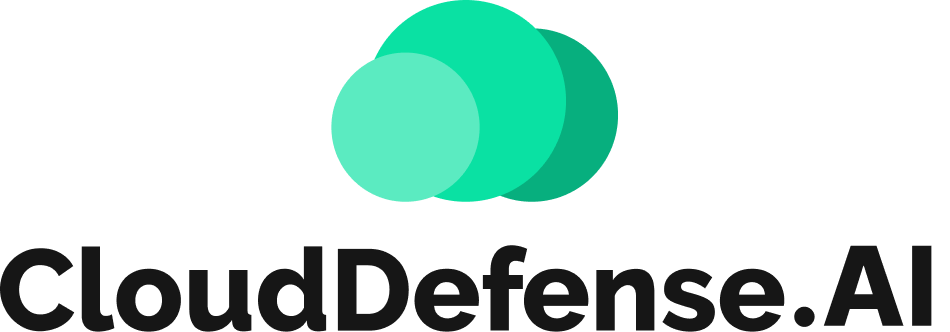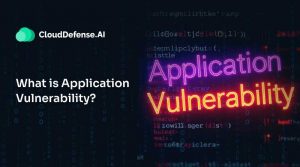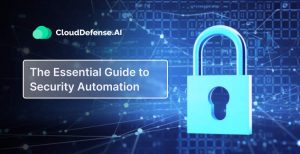Understanding Cloud Malware: Types, Risks, and How to Defend Your Business
We imagine your cloud environment as a serene, digital meadow. Everything seems peaceful until you spot a small, inconspicuous bug. That bug, my friend, is cloud malware. It’s a tiny, often invisible threat that can wreak havoc on your entire digital ecosystem.
With over 68% of malware attacks now originating from cloud apps, it’s a plague spreading rapidly through the cloud. And the worst part? Many businesses are completely unaware of the danger lurking right under their noses.
Keep reading as we uncover for you what cloud malware is, why it’s so dangerous, and how you as a business can protect yourself from falling victim to it.
What is Cloud Malware?
Cloud malware refers to malicious software specifically designed to target cloud computing environments. It infiltrates cloud infrastructure, cloud applications, and virtualized systems with the intent to steal sensitive data, disrupt operations, or gain unauthorized access to an organization’s network.
Since cloud services are interconnected and widely used for everything from data storage to critical business applications, they provide an appealing attack surface for cybercriminals. Unlike traditional malware that affects physical hardware, cloud malware often goes unnoticed until the damage is done.
It can infiltrate through various means that include phishing emails, exploiting server vulnerabilities, or using compromised third-party software. As businesses continue to shift operations to the cloud, the need for heightened awareness and security grows more urgent.
Why is Cloud Malware Destructive for Businesses?
The destructive potential of cloud malware lies in its ability to infiltrate deeply into a business’s cloud infrastructure. Since cloud environments often host critical data and services, an attack can bring operations to a halt, steal sensitive information, and cause significant financial and reputational damage.
For example, over 60% of small businesses hit by malware don’t survive the attack. The interconnected nature of cloud systems means a breach in one area can easily spread across the entire network. Additionally, businesses lose control over the hardware when they rely on cloud providers like AWS, Microsoft Azure, or Google Cloud.
This lack of control means that companies depend on their cloud provider’s security measures to prevent attacks, but any vulnerability in the cloud ecosystem can still result in catastrophic data breaches or downtime.
Cloud Malware Statistics
Cloud malware is a major threat today. Here are some recent statistics to illustrate the severity of the issue:
- According to Netskope’s 2023 Cloud and Threat Report, cloud-native attacks increased by 20% in 2022 and will continue to increase in 2025.
- According to IBM’s cost of a data breach report, the average cost of a data breach is $5.17 million. A significant portion of these data breaches can be attributed to cloud malware, resulting in millions of dollars in losses.
- Phishing remains the most common attack vector, accounting for 43% of all cyberattacks.
- A study by Netwrix found that 86% of cloud attacks in the healthcare sector lead to financial losses or other negative consequences.
These statistics are enough to state the importance of top-notch cloud security measures to protect against the threat of cloud malware.
Types of Cloud Malware
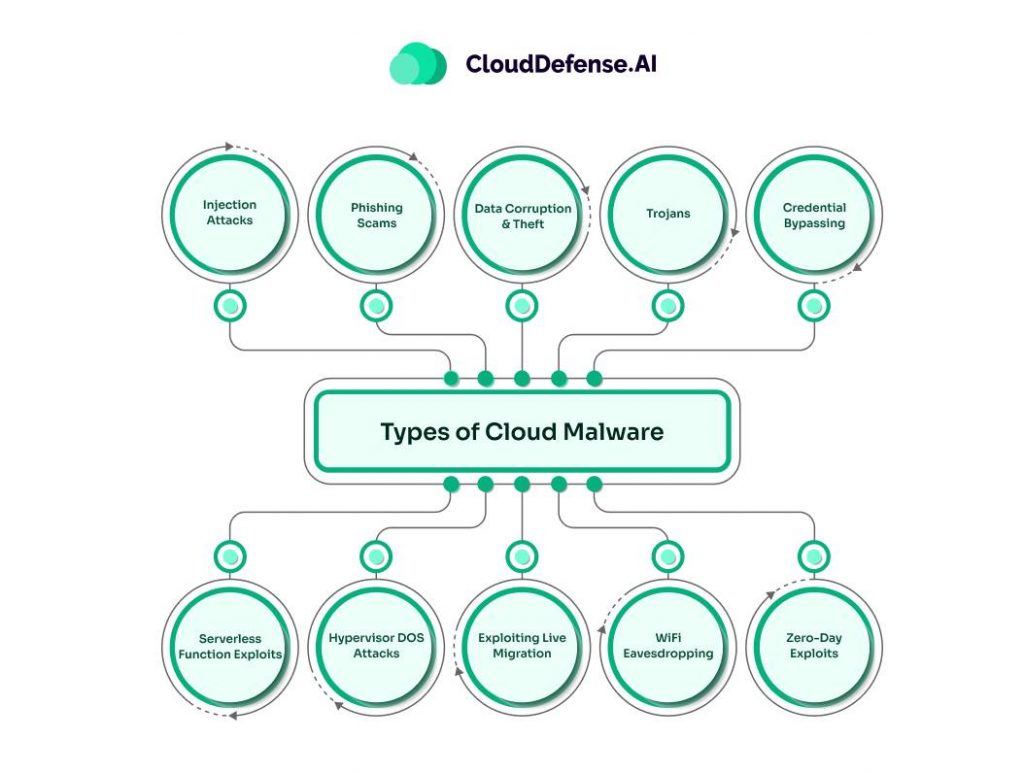
Cloud malware comes in various forms, from ransomware and botnets to cryptojacking and data breaches, targeting cloud infrastructures. These threats exploit vulnerabilities in cloud services, aiming to compromise data, disrupt operations, or steal resources. Understanding these malware types can greatly assist you in protecting your cloud environment effectively.
1. Injection Attacks
In an injection attack, malicious code is inserted into an application or system, allowing hackers to take over and control cloud resources. This often happens through vulnerabilities in APIs or unpatched software. Once inside, attackers can steal data, plant ransomware, or even monetize the breach by selling access to your infrastructure.
Protection from Injection Attacks
- Ensure regular patch management and monitor all system access points for unusual activity to detect and prevent injection attacks.
2. Phishing Scams
Phishing involves sending fake emails or messages that trick users into sharing sensitive information or downloading malicious software. Once in, the malware spreads through the cloud system, compromising everything from personal data to financial records.
Protection from Phishing
- Implement MFA and train employees to recognize suspicious emails, attachments, or requests for sensitive information.
3. Data Corruption and Theft
Cloud malware frequently aims to corrupt or steal data, leaving businesses vulnerable. In some cases, cybercriminals may not just steal the data but also destroy or manipulate it, making it difficult for companies to recover.
Protection from Data Corruption
- Data encryption and regular backups are essential to minimizing damage from this kind of attack.
4. Trojans
Trojans disguise themselves as legitimate software but secretly harbor malicious intent. They can infiltrate your cloud network, allowing hackers access to sensitive data and business-critical applications.
Protection from Trojans
- Avoid downloading unauthorized software and use efficient endpoint security solutions to detect and block Trojans.
5. Credential Bypassing
Attackers use brute force or phishing methods to obtain admin credentials, allowing them to bypass security measures and take full control of cloud accounts.
Protection from Credential Bypassing
- Enforce strict password policies, limit admin privileges, and implement MFA across all cloud services.
6. Serverless Function Exploits
Cloud environments increasingly use serverless architectures. However, poorly secured serverless functions and APIs can be exploited by attackers to run malicious code and disrupt services.
Protection from Serverless Function Exploits
- Regularly scan for vulnerabilities and ensure all APIs and serverless functions are up-to-date with the latest security patches.
7. Hypervisor DOS Attacks
Hypervisors manage virtual machines in cloud environments. A denial-of-service (DOS) attack against a hypervisor can cause the cloud service to crash, making applications and data unavailable.
Protection from Hypervisor DOS Attacks
- Maintain a solid monitoring system and limit access to hypervisor functions to reduce the risk of overload and exploitation.
8. Exploiting Live Migration
Live migration lets virtual machines move between physical hosts, but if exploited, attackers can gain unauthorized access to the underlying infrastructure.
Protection from Exploiting Live Migration
- Ensure that migration processes are secure and that access control policies are strictly enforced.
9. WiFi Eavesdropping
This attack involves intercepting WiFi communications, allowing hackers to gain access to cloud services or applications by capturing network traffic.
Protection from WiFi Eavesdropping
- Always use secure, encrypted WiFi networks and regularly change passwords for enhanced protection.
10. Zero-Day Exploits
A zero-day exploit targets an unknown vulnerability, catching businesses off-guard and allowing attackers to infiltrate systems before a patch is available.
Protection from Zero-Day Exploits
- Stay updated with the latest security patches and keep an eye on emerging threats to reduce the risk of zero-day exploits.
How to Protect from Cloud Malware?
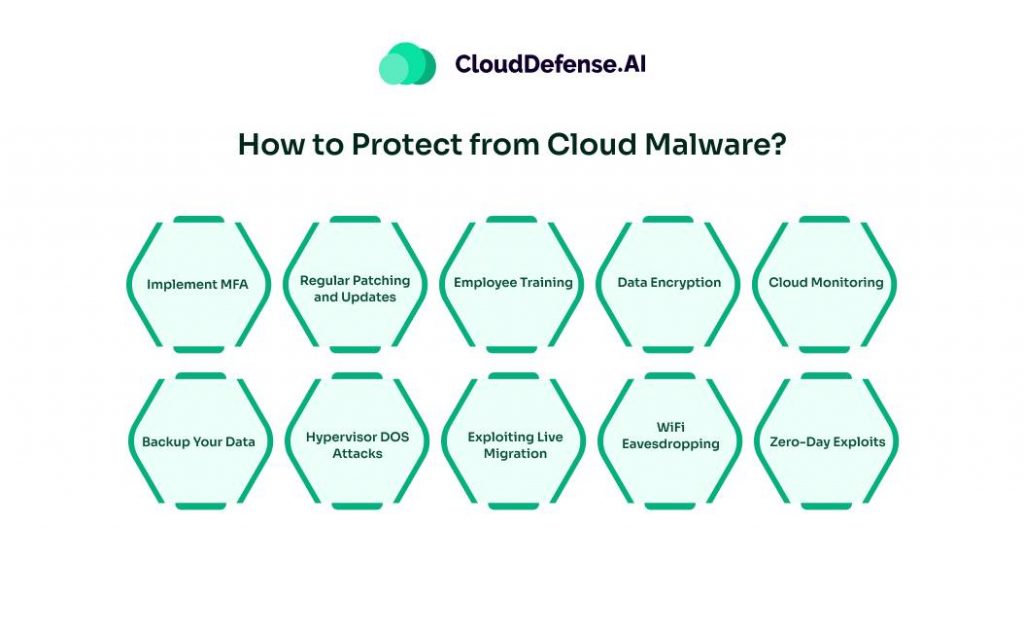
Protecting your business from cloud malware requires a proactive approach. By implementing key security practices and staying vigilant, you can minimize risks and defend your cloud environment. Below are essential strategies to help prevent malware attacks and ensure the safety of your data and operations in the cloud.
1. Implement MFA
Multi-factor authentication adds an essential layer of protection by requiring users to provide two or more verification factors to gain access to a system. This makes it much harder for attackers to use stolen credentials.
Even if a password is compromised, MFA significantly reduces the likelihood of unauthorized access by requiring a secondary method, like a text message code or an authentication app. For cloud environments where data is easily accessible, MFA is one of the most effective defenses against cloud malware.
2. Regular Patching and Updates
One of the most common ways malware infiltrates cloud systems is through unpatched vulnerabilities. Cybercriminals often exploit outdated software or security flaws that have been previously identified but not fixed. Regularly updating your cloud software, applications, and APIs ensures that these security gaps are closed.
Many cloud providers release regular updates and patches to fix bugs and security vulnerabilities, and it’s crucial to apply these patches immediately. Automating this process can help ensure no critical updates are missed.
3. Employee Training
Human error is often a weak link in any security strategy. One of the best ways to protect against cloud malware is by ensuring that your employees are educated on cybersecurity best practices. This includes training them to recognize phishing emails, suspicious links, and other social engineering attacks.
Employees should be encouraged to use strong, unique passwords for their accounts and should avoid reusing passwords across multiple platforms. Regular security awareness programs can go a long way in reducing the chances of malware infections caused by unintentional employee actions.
4. Data Encryption
Encrypting data is a fundamental security measure in protecting sensitive information stored in the cloud. Whether data is at rest (stored) or in transit (being transferred between systems), encryption ensures that even if the data is intercepted, it cannot be read without the decryption key.
Encryption adds an extra layer of security, especially for businesses dealing with highly sensitive information like customer records, financial data, or proprietary business information. It’s important to use strong encryption standards and ensure that encryption keys are securely managed.
5. Cloud Monitoring
Constantly monitoring your cloud environment for any unusual activity is critical for early detection of malware infections. Cloud monitoring tools allow you to track data access patterns, network traffic, and user activities in real-time.
Abnormal behavior, such as a spike in data access requests, unauthorized downloads, or unusual login times, can indicate a potential malware attack. By setting up alerts and automated responses, you can quickly address security threats before they escalate.
6. Backup Your Data
Regular data backups are essential for minimizing the damage caused by cloud malware attacks. In the event that malware corrupts or locks you out of your data, a backup allows you to restore your systems quickly and continue operations with minimal downtime. However, simply backing up data isn’t enough.
You should also regularly test your backup procedures to ensure that the backups are functioning correctly and that you can recover your data swiftly when needed. A well-executed backup and recovery plan can be a lifesaver in the face of ransomware or other destructive malware.
Protect Your Cloud Environment from Malware with CloudDefense.AI
It is a no-brainer that businesses need more than basic protection to secure their cloud environments. CloudDefense.AI offers an advanced CNAPP that delivers end-to-end security for your cloud infrastructure and applications, ensuring complete defense against the most complex malware attacks.
What sets CloudDefense.AI apart is its all-in-one solution, which addresses everything from code vulnerabilities to cloud reconnaissance. With features like SAST, DAST, SCA, IaC Analysis, Advanced API Security, Container Security, CSPM, DSPM, CWPP, CADR, and CIEM, it leaves no stone unturned in keeping your data and cloud operations secure. Our exclusive Hacker’s View™ technology gives businesses a proactive edge, offering unparalleled insight into potential threats.
CloudDefense.AI goes beyond traditional defenses by actively reducing zero-day threats and reducing vulnerability noise, delivering five times the value of conventional tools. For organizations seeking top-tier, all-inclusive cloud protection, CloudDefense.AI is the ultimate solution to outsmart cloud malware and keep your operations safe.
Start protecting your business with CloudDefense.AI today. Book a free demo now!
